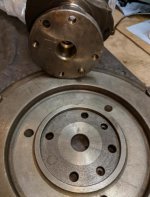I noticed my flywheel has two holes for the crankshaft dowel located 90-degrees apart. This means the crankshaft can be installed in two different orientations, which I confirmed. The service manual says to install with the arrow on the flywheel aligned with TDC of #1 and #4. This is simple enough to do, but why even have the other hole? I thought the entire purpose of the dowel is to ensure proper alignment, but the existence of the second hole seems to undermine the reason for its existence.
Also, it appears that there is a round rust spot on the flywheel under where the crankshaft empty dowel hole was located. What's interesting is that orientation would put the arrow on the flywheel not aligned with TDC of #1 and #4. So the question I have is - does flywheel-crankshaft alignment really matter?

Also, it appears that there is a round rust spot on the flywheel under where the crankshaft empty dowel hole was located. What's interesting is that orientation would put the arrow on the flywheel not aligned with TDC of #1 and #4. So the question I have is - does flywheel-crankshaft alignment really matter?


 Hi Guest!
Hi Guest!

 smilie in place of the real @
smilie in place of the real @
 Pretty Please - add it to our Events forum(s) and add to the calendar! >>
Pretty Please - add it to our Events forum(s) and add to the calendar! >> 